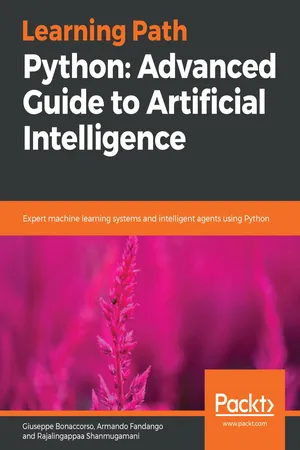
Python: Advanced Guide to Artificial Intelligence
Expert machine learning systems and intelligent agents using Python
Giuseppe Bonaccorso, Armando Fandango, Rajalingappaa Shanmugamani
- 764 páginas
- English
- ePUB (apto para móviles)
- Disponible en iOS y Android
Python: Advanced Guide to Artificial Intelligence
Expert machine learning systems and intelligent agents using Python
Giuseppe Bonaccorso, Armando Fandango, Rajalingappaa Shanmugamani
Información del libro
Demystify the complexity of machine learning techniques and create evolving, clever solutions to solve your problems
Key Features
- Master supervised, unsupervised, and semi-supervised ML algorithms and their implementation
- Build deep learning models for object detection, image classification, similarity learning, and more
- Build, deploy, and scale end-to-end deep neural network models in a production environment
Book Description
This Learning Path is your complete guide to quickly getting to grips with popular machine learning algorithms. You'll be introduced to the most widely used algorithms in supervised, unsupervised, and semi-supervised machine learning, and learn how to use them in the best possible manner. Ranging from Bayesian models to the MCMC algorithm to Hidden Markov models, this Learning Path will teach you how to extract features from your dataset and perform dimensionality reduction by making use of Python-based libraries.
You'll bring the use of TensorFlow and Keras to build deep learning models, using concepts such as transfer learning, generative adversarial networks, and deep reinforcement learning. Next, you'll learn the advanced features of TensorFlow1.x, such as distributed TensorFlow with TF clusters, deploy production models with TensorFlow Serving. You'll implement different techniques related to object classification, object detection, image segmentation, and more.
By the end of this Learning Path, you'll have obtained in-depth knowledge of TensorFlow, making you the go-to person for solving artificial intelligence problems
This Learning Path includes content from the following Packt products:
- Mastering Machine Learning Algorithms by Giuseppe Bonaccorso
- Mastering TensorFlow 1.x by Armando Fandango
- Deep Learning for Computer Vision by Rajalingappaa Shanmugamani
What you will learn
- Explore how an ML model can be trained, optimized, and evaluated
- Work with Autoencoders and Generative Adversarial Networks
- Explore the most important Reinforcement Learning techniques
- Build end-to-end deep learning (CNN, RNN, and Autoencoders) models
Who this book is for
This Learning Path is for data scientists, machine learning engineers, artificial intelligence engineers who want to delve into complex machine learning algorithms, calibrate models, and improve the predictions of the trained model.
You will encounter the advanced intricacies and complex use cases of deep learning and AI. A basic knowledge of programming in Python and some understanding of machine learning concepts are required to get the best out of this Learning Path.
Preguntas frecuentes
Información
EM Algorithm and Applications
- Maximum Likelihood Estimation (MLE) and Maximum A Posteriori (MAP) learning approaches
- The EM algorithm with a simple application for the estimation of unknown parameters
- The Gaussian mixture algorithm, which is one the most famous EM applications
- Factor analysis
- Principal Component Analysis (PCA)
- Independent Component Analysis (ICA)
- A brief explanation of the Hidden Markov Models (HMMs) forward-backward algorithm considering the EM steps
MLE and MAP learning







Índice
- Title Page
- Copyright and Credits
- About Packt
- Contributors
- Preface
- Machine Learning Model Fundamentals
- Introduction to Semi-Supervised Learning
- Graph-Based Semi-Supervised Learning
- Bayesian Networks and Hidden Markov Models
- EM Algorithm and Applications
- Hebbian Learning and Self-Organizing Maps
- Clustering Algorithms
- Advanced Neural Models
- Classical Machine Learning with TensorFlow
- Neural Networks and MLP with TensorFlow and Keras
- RNN with TensorFlow and Keras
- CNN with TensorFlow and Keras
- Autoencoder with TensorFlow and Keras
- TensorFlow Models in Production with TF Serving
- Deep Reinforcement Learning
- Generative Adversarial Networks
- Distributed Models with TensorFlow Clusters
- Debugging TensorFlow Models
- Tensor Processing Units
- Getting Started
- Image Classification
- Image Retrieval
- Object Detection
- Semantic Segmentation
- Similarity Learning
- Other Books You May Enjoy